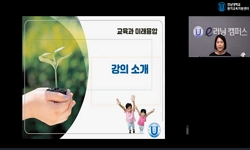The purpose of this study is to develop a lesson plans for clothing life that will improve digital literacy competencies at home economics education. For this purpose, lesson plans were developed that reflects the three components of digital literacy,...
http://chineseinput.net/에서 pinyin(병음)방식으로 중국어를 변환할 수 있습니다.
변환된 중국어를 복사하여 사용하시면 됩니다.
- 中文 을 입력하시려면 zhongwen을 입력하시고 space를누르시면됩니다.
- 北京 을 입력하시려면 beijing을 입력하시고 space를 누르시면 됩니다.

디지털 리터러시 함양을 위한 가정교과 수업과정안 개발: 2022 개정 가정과 교육과정 의생활 영역을 중심으로 = Development of Home Economics Lesson Plans Aimed at Enhancing Digital Literacy: Focusing on the 2022 Revised Home Economics Curriculum for Clothing Life Field
한글로보기부가정보
다국어 초록 (Multilingual Abstract)
The purpose of this study is to develop a lesson plans for clothing life that will improve digital literacy competencies at home economics education. For this purpose, lesson plans were developed that reflects the three components of digital literacy, content and digital technologies. The lesson plans are divided into five topics: self-image expression, clothing materials and care practices, sustainable clothing planning, resource cycles and human choices, and culture and future change in the clothing life-cycle. Each of these themes uses digital resources to develop digital literacy abilities in accordance with the STPCR's instructional stages. Gané's goal statement is used to express the general goal of each topic, which is then followed by particular objectives to achieve it. The lesson plans have the following characteristics: 1) Using digital tools to improve digital literacy skills; 2) Understanding and applying the value of resource circulation and sustainability; 3) Increasing class engagement and learning motivation; and 4)Fostering collaboration and critical thinking abilities through peer assessment and feedback. One weakness of this study is that the lessons learned were not used in the field. However, a limitation of this study is that the developed lesson plans have not been applied in the field. Therefore, it is necessary to verify the effectiveness of the lesson-plan in enhancing digital literacy skills through field application. Further research is needed to identify optimized digital tools and platforms and provide practical utilization strategies for educators.
동일학술지(권/호) 다른 논문
-
텍스트 마이닝 기법을 활용한 온라인 뉴스 기사의 중장년 주거 토픽 분석
- 대한가정학회
- 황윤서
- 2024
- KCI등재
-
지속가능한 패션브랜드의 스토리텔링과 지속가능성에 대한 소비 가치가 소비자 신뢰와 구매의도에 미치는 영향
- 대한가정학회
- 임수연
- 2024
- KCI등재
-
사티어 이론에 기반한 중학교 가정과 의사소통 프로그램 개발
- 대한가정학회
- 박희진
- 2024
- KCI등재
-
주거복지 전문인력의 지역사회자원 연계 과정과 업무 중요도 인식
- 대한가정학회
- 지은영
- 2024
- KCI등재




 ScienceON
ScienceON KISS
KISS





